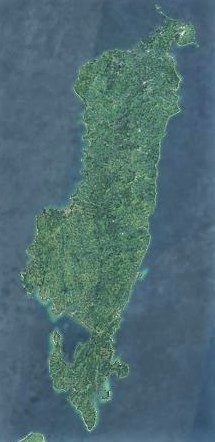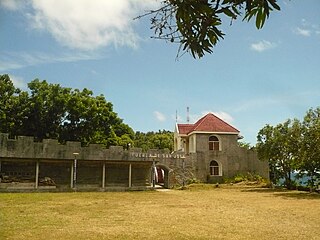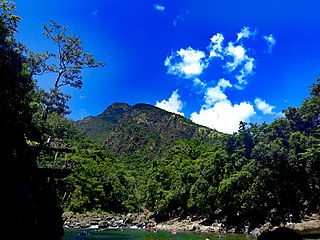
Romblon, officially the Province of Romblon, is an archipelagic province of the Philippines located in the Mimaropa region. Its main components include Romblon, Romblon, an archipelagic municipality of the same name that also serves as the provincial capital; Tablas, the largest island, covering nine municipalities; Sibuyan with its three towns; as well as the smaller island municipalities of Corcuera, Banton, Concepcion, San Jose. The province lies south of Marinduque and Quezon, east of Oriental Mindoro, north of Aklan and Capiz, and west of Masbate. According to the 2020 census, it has a total population of 308,985.

Mimaropa, officially the Southwestern Tagalog Region, is an administrative region in the Philippines. It is one of two regions in the country having no land border with another region. The name is an acronym combination of its constituent provinces: Mindoro, Marinduque, Romblon and Palawan.

Tablas is the largest of the islands that comprise the province of Romblon in the Philippines. The name of the island is of Spanish origin. Before the colonization of the Philippines, Tablas was known as the Island of Osigan. At the time of contact with Westerners, Osigan had a population of 256 people living in small villages. Wax was produced in this island.

San Fernando, officially the Municipality of San Fernando, is a 4th class municipality in the province of Romblon, Philippines. According to the 2020 census, it has a population of 24,171 people.

Alcantara, officially the Municipality of Alcantara, is a 5th class municipality in the province of Romblon, Philippines. According to the 2020 census, it has a population of 17,171 people.

Banton, officially the Municipality of Banton, is a 5th class municipality in the province of Romblon, Philippines. According to the 2020 census, it has a population of 5,737 people.

Cajidiocan, officially the Municipality of Cajidiocan, is a 3rd class municipality in the province of Romblon, Philippines. According to the 2020 census, it has a population of 23,259 people. The municipality is located on Sibuyan Island, which has been dubbed as the "Galapagos of Asia" due to its pristine natural environment and high endemism rate for flora and fauna.

Concepcion, officially the Municipality of Concepcion, is a 6th class municipality in the province of Romblon, Philippines. The municipality is coextensive with Maestre de Campo Island, which is also known as Sibale Island. According to the 2020 census, it has a population of 3,561 people, making it the least populated town in the province.

Corcuera, officially the Municipality of Corcuera, is a 5th class municipality in the province of Romblon, Philippines. According to the 2020 census, it has a population of 10,112 people.

Calatrava, officially the Municipality of Calatrava, is a 5th class municipality in the province of Romblon, Philippines. According to the 2020 census, it has a population of 11,342 people.

Ferrol, officially the Municipality of Ferrol, is a 6th class municipality in the province of Romblon, Philippines. According to the 2020 census, it has a population of 8,005 people.

Magdiwang, officially the Municipality of Magdiwang, is a 5th class municipality in the province of Romblon, Philippines. According to the 2020 census, it has a population of 15,385 people.

Odiongan, officially the Municipality of Odiongan, is a 1st class municipality in the province of Romblon, Philippines. According to the 2020 census, it has a population of 49,284 people. It is composed of 25 barangays.

Romblon, officially the Municipality of Romblon, is a 3rd class municipality and capital of the province of Romblon, Philippines. According to the 2020 census, it has a population of 40,554 people. The archipelagic municipality is the capital of the province of Romblon and the seat of its provincial government. It includes Romblon Island as well as the nearby islands of Lugbon, Alad and Cobrador.

San Andres, officially the Municipality of San Andres,, is a 5th class municipality in the province of Romblon, Philippines. According to the 2020 census, it has a population of 15,940 people.

San Agustín, officially the Municipality of San Agustín,, is a 4th class municipality in the province of Romblon, Philippines. According to the 2020 census, it has a population of 24,115 people.

San Jose, officially the Municipality of San Jose, is a 5th class municipality in the province of Romblon, Philippines. According to the 2020 census, it has a population of 11,759 people.

Santa Fe, officially the Municipality of Santa Fe, is a 5th class municipality in the province of Romblon, Philippines. According to the 2020 census, it has a population of 17,802 people.

Santa Maria, officially the Municipality of Santa Maria,, is a 5th class municipality in the province of Romblon, Philippines. According to the 2020 census, it has a population of 8,989 people.

Looc, officially the Municipality of Looc, is a 5th class municipality in the province of Occidental Mindoro, Philippines. According to the 2020 census, it has a population of 7,802 people, making it the least populated municipality in the province.
























